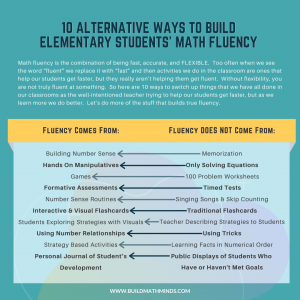Resources mentioned in this episode:
NCTM President Message by Linda M. Gojak, NCTM Summing Up, November 1, 2012
Fast Does NOT Mean Fluent video
How to write a review on iTunes and Stitcher
Build Math Minds Podcast on Stitcher
Build Math Minds Podcast on iTunes (must be on a phone to leave a review using this link. If on a computer open up iTunes and search for the Build Math Minds podcast.)
Welcome fellow Recovering Traditionalists to Episode 53. Today we are looking at why Fluency is NOT Just Fast & Accurate.
Before we get started I want to announce the first winner of our anniversary giveaway.

So KK2ndgrade send me a DM or email me what book you want me to send you.
I have four more books to give away so if you want to enter, go to iTunes or Stitcher to leave me a rating and a review. In your review, let people know what you think about the podcast. In the review you can let me know which podcast about a book this past year was your favorite and if you get selected, I’ll send you that book. If you don’t have a favorite book podcast I did, then if you are drawn for the giveaway you can tell me which book you’d like.
Over on my vlog I posted a video this week about how fast does not mean children are fluent. As I was doing some research on this I came across a President’s Message by then NCTM President Linda Gojak. In this message, Linda states:
“As mathematics educators at all levels consider effective implementation and instruction related to state or Common Core standards, a frequently asked question is, ‘What does it mean to be fluent in mathematics?’ The answer, more often than not, is, ‘Fast and accurate.’ Building fluency should involve more than speed and accuracy. It must reach beyond procedures and computation.
Principles and Standards for School Mathematics states, ‘Computational fluency refers to having efficient and accurate methods for computing. Students exhibit computational fluency when they demonstrate flexibility in the computational methods they choose,understand and can explain these methods, and produce accurate answers efficiently. The computational methods that a student uses should be based on mathematical ideas that the student understands well, including the structure of the base-ten number system, properties of multiplication and division, and number relationships’ (p. 152). What a wonderful description of fluency! It reminds us that a student cannot be fluent without conceptual understanding and flexible thinking.”
I completely agree and that’s why in my recent video (which I’ll link to on the show notes) I discuss 10 Alternative Ways to Build Elementary Students’ Math Fluency. I’ll read through them here but if you want more detail please go watch the full video. I’ve also created a nice image that shows these 10 shifts and I’d love for you to download it, share it out on social media, and tag me @buildmathminds.

Okay, here are the ten alternatives.
Instead of having kids memorize, let’s build number sense.
Instead of having kids just solve equations, let’s have them work with hands-on manipulatives.
Instead of 100 problem worksheets for practice, let’s let kids play games.
Instead of singing songs and skip counting, let’s do number sense routines.
Instead of using traditional flashcards, let’s use interactive & visual flashcards.
Instead of teachers describing strategies to students, let the students explore strategies using visuals.
Instead of teaching tricks, let’s help our students use number relationships.
Instead of learning facts in numerical order, let’s do strategy-based activities.
Instead of public displays of students who have or haven’t met goals, let’s have students keep personal journals of their development.
Now this list is not the end of the conversation about how we build fluency, I want it to be the start of the conversation. So if you share the image out there on Twitter or Instagram, tag me and let me know if there is anything you would add to this list.
If you like what you have been hearing there are a few ways I would love for you to let me know. The first way is to subscribe to the podcast. If you are listening in iTunes make sure to hit that subscribe button. Also in iTunes I would love for you to leave a review and let me know if you are enjoying the podcast which types of episodes are your favorite. Really just anything to get me feedback about the show and lastly if you are on Instagram or Twitter I would love for you to share when you listen to an episode that you love. Make sure you tag me @buildmathminds and all of those are the ways to let me know that there are actually people out there listening. Thank you so much for letting me be a small part of your math journey.
Subscribe and Review in iTunes
Hey, are you subscribed to the Build Math Minds Podcast, yet? If you’re not, make sure to do that today because I don’t want you to miss any episodes! Click here to subscribe to the podcast in iTunes.
While you’re there, don’t forget to leave a review on iTunes too. I would love to know your thoughts and how we can make sure that we give you content that you will really enjoy.
To leave a review, head over to iTunes and click on “Ratings and Reviews” and “Write a Review.” I can’t wait to hear your thoughts about the podcast.




